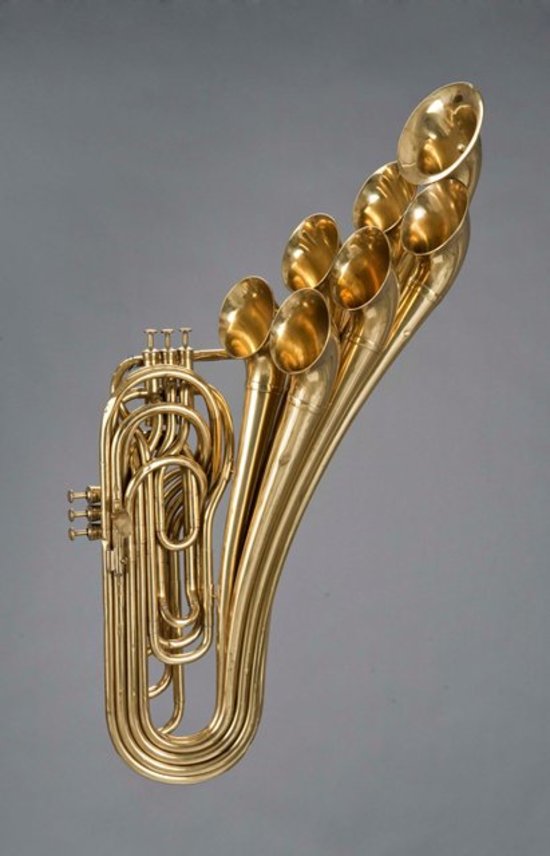Yesterday afternoon I got excited about a new design for a brass instrument. Conical bore instruments have the problem that you can’t combine valves (or slides) with having the tubing consistently expand over the length of the instrument. The valves force you to have a cylindrical bore segment in the center, and while you can design the tubing to minimize the cylindrical segment, you do have to have some.
Or do you? Imagine you have seven bells, with a single rotary valve that has seven positions, one for each bell. You use the standard fingering, with keys to rotate the valve 1⁄7, 2⁄7, and 3⁄7. This gets you approximately the same options for tubing length as a standard brass instrument, except that you no longer need to make compromises: pushing in all three keys brings you down exactly six half steps and you don’t need a tuning slide to compensate. You can play chromatically, and you play it just like a trumpet, baritone, or tuba.
It looks like Adolphe Sax tried something like this, but with six two-position piston valves instead of a seven-position rotary valve, and he was just trying to solve the tuning problem and not the bore problem:
But then I found something even weirder: 1, 2, 3, 4, 5.
It turns out there’s a somewhat successful instrument along these lines, but for totally different reasons. Instead of being optimized for tone, it’s optimized for being easy to play. Each instrument has one horn per note, typically eight, so a range of just eight notes. The base of each horn has a reed, so you don’t need any sort of embouchure, you just blow. See this video where someone takes one apart to demonstrate. They seem to be German; to find more videos search for “Schalmeien”, while if you want to buy one (please don’t) search for “Schalmei”.
I do think a rotary trumpet, played chromatically with trumpet fingering, could work well though, and I’m curious whether anyone has explored this.
Comment via: facebook

The word Schalmei can mean some different things:
https://de.wikipedia.org/wiki/Schalmei_(Begriffskl%C3%A4rung)
The kind of brass instrument you refer to is also called Martinstrompete, see https://de.wikipedia.org/wiki/Martinstrompete and https://de.wikipedia.org/wiki/Folgetonhorn#Martin-Horn/Martinshorn (In German, “Martinshorn” is also the word for the sound-making thing in fire engines, and yes that is technically related.)
Why the request to not buy one?
Watch the last linked video and listen to the opinion, then form your own. You might come to the same conclusion. :-)
By the way, I’m German and as a child I liked to hear the Schalmeienkapelle of my village play. If I heard them live these days, however, I might want to get out of earshot quickly. Then again, it might take time to develop an appreciation. The strangest musical styles exist around the world.